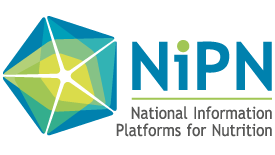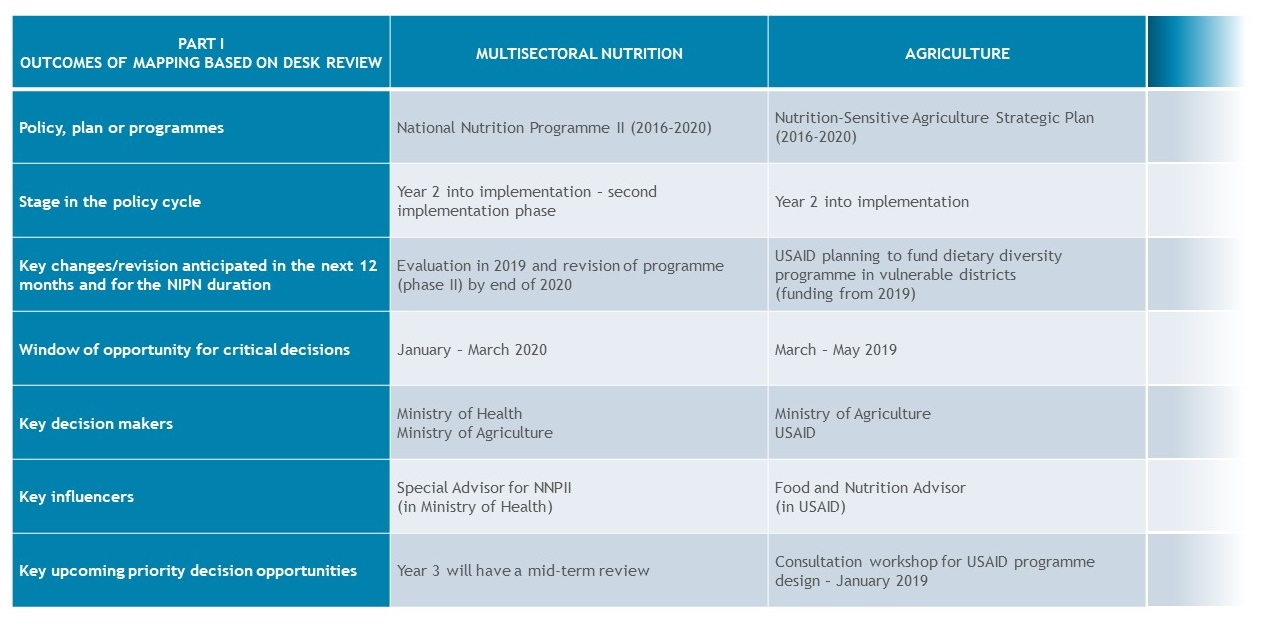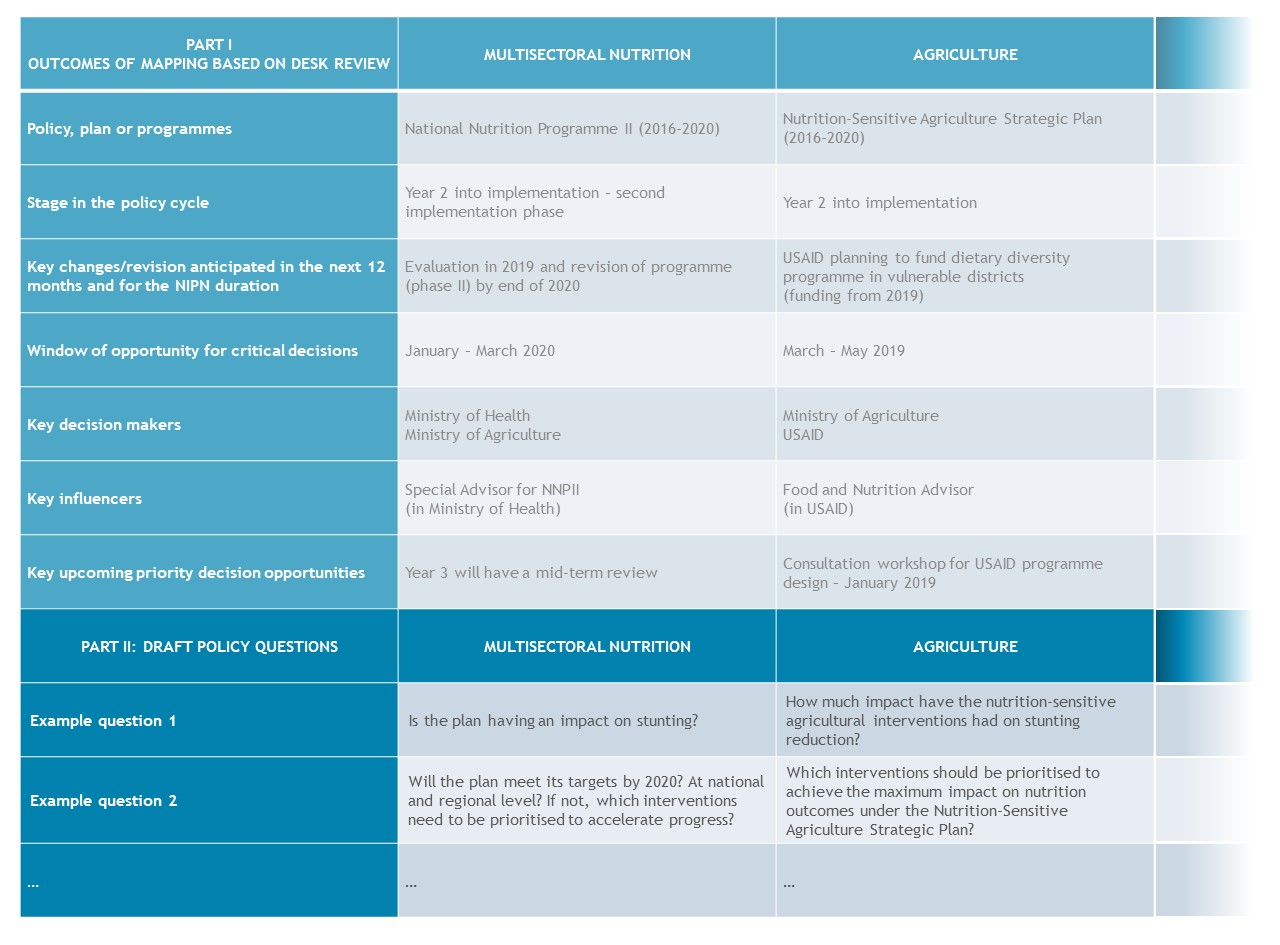Identifying nutrition policy demand and initial questions
-
STEP 1: Identify nutrition policy demand and gather initial questions
Objectives:
- To map the key opportunities for influencing policy, programming and investment decisions by identifying policy priorities of key nutrition-related sectors and time frames for decision making.
- To gather initial questions of key nutrition-related sectors.
*****Activities:
- Activity A: Mapping key opportunities for influencing policy, programming and investment.
- Activity B: Gathering initial questions for each priority.
*****Outputs:
- Matrix of key opportunities for influencing policy, programming and investment decisions and priority questions.
***** -
Scope of the question formulation process
The NIPN country team will need to make certain strategic choices at the outset of the question formulation process.
- The NIPN approach is usually positioned to support a specific multisectoral nutrition policy or plan of action (MPPA). This focus is key to ensuring that the identified questions and subsequent analyses will respond to a specific need, that the appropriate decision makers are being engaged early on in the process, and that the answers to the questions are actionable and have the potential to influence a particular decision. For countries without a multisectoral nutrition policy or plan of action, it is recommended that a strategic decision is made on which nutrition policy, strategy, plan of action or possibly programme, the question formulation process will focus.
- Furthermore, the NIPN country team will need to make a strategic decision whether to engage with all sectors contributing to the MPPA at the same time or whether to initially work with a subset of these, and subsequently engage the others. For countries without an MPPA, a similar choice needs to be made regarding whether to focus on all sectors that are likely to contribute to improved nutrition or only a few of them.
*****The decision on which and how many sectors to engage in the NIPN operational cycle depends on several factors:
- The existing structure of multisectoral coordination and the feasibility of engaging multiple sectors.
- The capacity of the NIPN team to manage collaboration and data analyses with multiple sectors at the same time.
This decision is likely to be a trade-off between bringing everyone on board to ensure a multisectoral approach and managing expectations around what can be delivered.
*****How many sectors to engage? Example of Guatemala Guatemala decided to engage with a subset of the 20+ ministries contributing to the National Food Security and Nutrition Policy (PESAN 2012-2020). A focus on the four key ministries responsible for implementing actions of the revised Strategy for Preventing Chronic Malnutrition (ENDPC 2016-2020) seemed more manageable and more likely to provide tangible opportunities to turn NIPN findings into improved actions and decisions on ENPDC implementation.***** -
Activity A: Mapping the key strategic opportunities for influencing policy, programming and investment decisions (1/2)
The mapping addresses the following questions:
- What upcoming priority decisions are expected to be made in nutrition?
- To which specific policy, programme or plan will they relate?
- Who will make the decisions?
- When will the decisions be made?
- What evidence and information are likely to be needed?
- Which administrative level is the focus of the decision (e.g. central or sub-national)?
This information is gathered by the NIPN country team through a desk review of existing literature (see additional information below).
The information should be verified and amended through stakeholder discussions with key government sectors, donors, UN and civil society groups, facilitated by the NIPN country team. The SUN platform may offer a good opportunity for these stakeholder discussions. The discussions may be in the form of focus groups or bilateral discussions and are particularly helpful in identifying the key opportunities to influence decision making (see next page).
*****The mapping aims to achieve the following:
- Identify at which stage the MPPA is or sector-specific nutrition policy and plans are;
- Assess coherence between the MPPA and sector-specific policies and plans (see the Mali example below);
- Identify upcoming ’windows of opportunity’ to influence decision making (e.g. the next 6 or 12 months);
- Depending on the above, confirm which policy, plan or programme the NIPN cycle of ‘questions-analysis-findings’ will focus on;
- Identify what types of information or findings are likely to be considered for these upcoming decision-making opportunities, and by when;
- Ensure that the NIPN operational cycle will provide answers and recommendations in line with the decision-making calendar;
- Define the target audience for the last step of the NIPN operational cycle regarding communication and dissemination of the answers to the policy questions.
*****Example: Policy question formulation in Mali based on the review of sectoral plans This example is based on the experience of the National Evaluation Platform (NEP) in Mali, a project led by Johns Hopkins University.
In 2014, the Mali Government was in the process of drafting a ten-year Plan for Sanitary and Social Development (PDDSS) 2014-2023. At that time, the National Evaluation Platform (NEP) team reviewed the draft 5-year PDDSS and a comparison with the Programme of Sanitary and Social Development III (PRODESS III), revealed the following:- The target mortality rates were already achieved and the baseline information of several interventions and targets were not coherent between the PDDSS and PRODESS III.
- The target population groups of the different health and nutrition programmes of the health sector were not harmonised.
- The proposed intervention package in PDDSS did not seem to correspond with the ambition of the mortality reduction targets of the PDDSS.
Confronted with this lack of coherence between the MPPA and sector-specific policies and plans, the relevant stakeholders decided to work towards a common and harmonised mortality reduction target which could be realistically achieved within the time frame of the PDDSS. The NEP team formulated policy questions in relation to the PDDSS targets and the proposed intervention packages, which were validated by the government stakeholders.
The finalisation of the PDDSS was postponed until 2015 to allow analyses using the Lives Saved Tool, a modelling software.
The analyses were carried out within the promised 6 months and results were available on time to redefine the PDDSS targets and refine the intervention packages, as part of the mid-year review process of PRODESS III.*****Desk review of existing literature -
Activity A: Outcome of the mapping exercise
The outcomes of the mapping exercise can be captured in a matrix summarising the key opportunities for influencing policy, programming and investment decisions (see Matrix Part I below).
- Each row in the matrix relates to a specific piece of information that has been collected during the mapping.
- Each column provides information relating to the policies, plans, programming and investments for one sector.
The matrix example below includes information from a fictional country. Only two columns have been filled (for multi-sectoral nutrition and agriculture). A full matrix would require completing the columns for all sectors that influence nutrition.
*****Matrix Part I ***** -
Five recommended exercises to help make a strategic decision
Based on the completed matrix part I, the five exercises proposed below will help to identify which areas to focus upon for filling the second part of the matrix (see next page). The NIPN team can decide which exercises are most relevant in their respective contexts but all are helpful for framing the broad policy context overview and triggering the initial reflections and exchanges.
*****Exercises -
Activity B: Gather initial questions
After having completed the policy review, the next activity will be to:
- Engage with the sectoral government counterpart and request them to formulate one to two priority policy questions which they consider highly relevant to their sector
- Capture these inputs in Part II of the matrix on key opportunities for influencing policy, programming and investment decisions (see example below)
The matrix exercise allows questions to be collected based on stakeholders’ priorities and sense of importance. At this stage, there is no need to apply other criteria; this will be done in the next steps.
*****Matrix Part II ***** -
Activity A: Mapping the key strategic opportunities for influencing policy, programming and investment decisions (2/2)
Identifying a window of opportunity
What are some examples of windows of opportunity or a “policy priority” that a NIPN operational cycle of ‘question-analysis-findings’ could inform?
- a policy or plan under development, revision or implementation
- an annual or mid-term policy review process
- a budget prioritisation exercise
- an annual planning exercise
It is important to be mindful of the stage in which policies and plans are: stakeholders’ priorities and interests will differ depending on the stage (evaluation, formulation or implementation), and this will influence the type of questions and information needs they may have.
Also keep in mind that the ‘window of opportunity’ may be more or less strict depending on the strategic priority considered: a programme’s evaluation or reformulation leaves a larger window of opportunity while a specific event, such as a conference or consultation workshop, has a fixed date, thus rendering the window of opportunity very narrow.
*****




